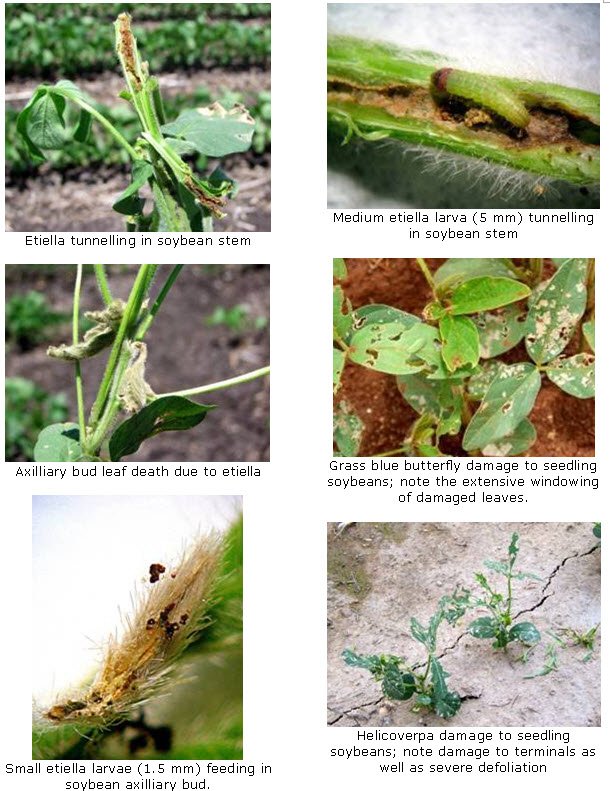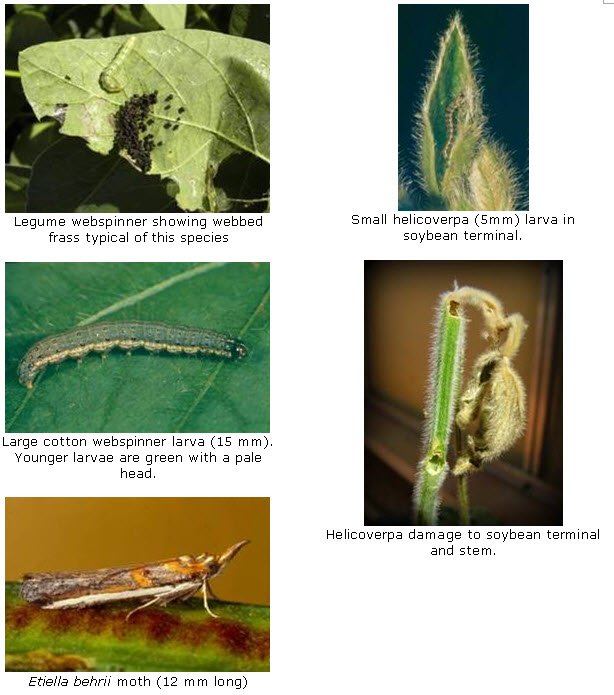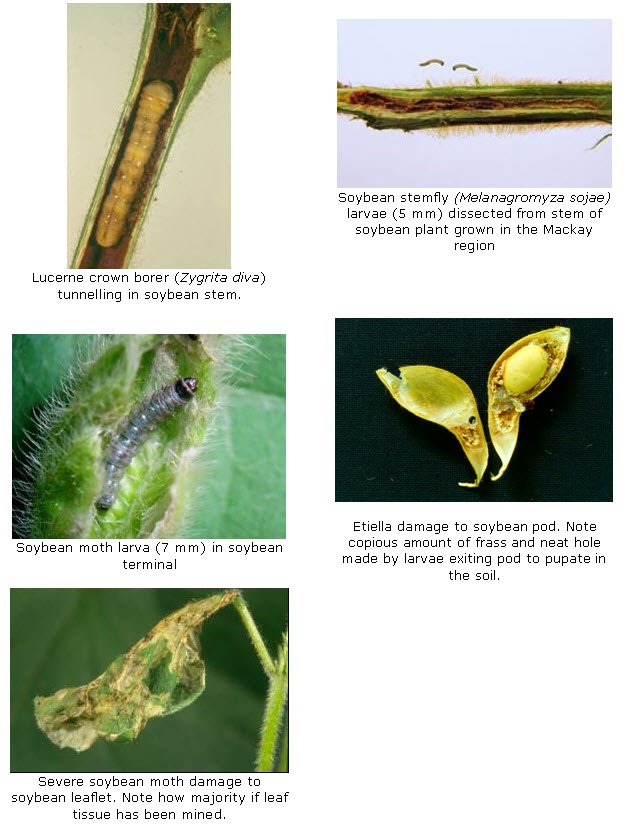Etiella (Etiella behrii) larvae have been observed in significant numbers (up to 10 larvae per square metre) in vegetative soybean crops in the Cecil Plains/ Pampas regions of the Darling Downs, and in low numbers (<1/sqm) in a DAFF soybean trial at Kingaroy.
These infestations are likely due to the current hot and dry seasonal conditions which historically favour increased etiella activity in other susceptible summer hosts, especially peanuts.
Damage of the magnitude observed to date is most likely not economically significant. This assertion is based on field experience with other pests damaging stems and buds in vegetative soybeans. Preliminary trials suggest larvae can’t be controlled effectively with current pesticides because of their sheltered feeding sites inside buds and stems.
Signs of an Etiella infestation in soybeans
Larvae are attacking terminals and axilliary buds and are also tunnelling in the stems. This feeding behaviour has been documented previously in peanuts but not to date in soybeans.
This season is certainly not the first time Etiella has infested vegetative soybeans. However, the low number of records suggests that either their damage has been either attributed to other pests, or the level of damage has been insufficient to trigger a closer examination to determine the pest responsible.
This season Etiella damage has been reported from crops at late podfill, although mostly at sub-economic levels. Etiella are a major pest of late podfill peanuts as etiella damage to pods greatly increases aflatoxin levels in harvested peanut seed.
The first readily visible etiella damage symptoms in vegetative soybeans are dead buds and terminals, but with few to no external signs of the tunnelling inside the stem. Dissection of infested plants from the infested crops revealed small larvae inside damaged terminals/buds, and larger larvae tunnelling in stems, feeding mainly on pith tissue.
Microscopic examination of dead buds/terminals suggests that damage to the plant’s vascular tissue as larvae tunnel towards the pith is responsible for the death of these structures. Not all damaged bud/terminal sites had subsequent tunnelling, suggesting that not all small larvae survive on vegetative soybeans.
Etiella tunnels have a brown discolouration and contain larval frass (poo). In contrast, undamaged pith tissue is almost white.

Etiella damage symptoms visible in the field, and that of similar species.
What impact might the infestations have on crop yields?
Soybeans can compensate for considerable axilliary bud damage but replacement buds and subsequent pods are often set lower on the plants, making for more difficult harvesting. It is unclear whether the etiella damage witnessed so far this season will result in lower pod set.
Extensive stem tunnelling may make the plants more brittle and prone to snapping off when being sampled vigorously with a beat sheet. Experience with other stem-tunnelling pests suggests this does not necessarily lead to lodging of the crop at or prior to harvest.
Identifying Etiella and distinguishing it from other pests causing similar symptoms in vegetative soybeans (across all soybean growing regions)
Small etiella larvae are cream with a dark head. Larger larvae (reaching 12 mm in length) are typically pale green with pink stripes and a dark red band behind the head.
Helicoverpa and grass blue butterfly larvae can kill terminals and axilliary buds, but don’t tunnel in stems. Grass blue feeding often results in the windowing of terminal and more-fully expanded leaves. Grass blue butterfly larvae are short (12 mm long) and slug like, while Helicoverpa are brown or green, with a parallel body, a pale stripe along their flanks, and characteristic pale striations on their back.
Helicoverpa damage to stems is usually coincidently inflicted when large larvae (on the outside of the stems) are targeting the plant’s axilliary buds. Such damage can have a major impact on yield, particularly if stems are severed and tops of the plant are lost.
Soybean moth larvae can attack vegetative terminals, but don’t tunnel in the stems. Larvae feed inside the leaves in leaf mines, which appear as translucent tan-coloured tissue. Soybean moth larvae reach 7 mm in length and are grey green in colour.
Legume and cotton webspinners web and fold leaves together. Legume webspinner is common in coastal soybeans but is rarely seen in more-inland crops. Outbreaks of cotton webspinners in soybeans are extremely rare but severe leaf damage (shredding) has been occasionally observed in seedling soybeans.
Zygrita or lucerne crown borer (Zygrita diva) larvae commonly tunnel in the stem’s pith, but tunnels originate from oviposition sites in the plant stem, not from the axilliary buds. Tunnels made by Zygrita are similar in appearance to etiella tunnels with a brown discolouration. Zygrita larvae are cream with a distinct thickening behind the head. They can reach 12 mm in length and are devoid of pink stripes and ventral prolegs. Zygrita only inflict economic damage if they pupate prior to pods reaching physiological maturity. This is because just prior to pupation, larvae ‘ringarbark’ the stem from the inside in order to plug the pupal chamber in the lower stem.
Soybean stemfly (Melanagromyza sojae) larvae have been reported tunnelling in soybean stems only in the Mackay region. The 5 mm long larvae are typical fly maggots and are translucent cream with no legs.

Etiella and other caterpillar species that will cause damage to soybeans similar to that being seen in association with Etiella.
Managing Etiella in vegetative soybeans
Etiella is a problematic pest, largely because of its concealed feeding behaviour, in this instance inside plant stems, buds and terminals. In vegetative soybeans, it is unclear what level of etiella activity would warrant control. As a rule of thumb, the threshold guidelines recommend action if greater than 25% terminal loss for terminal-attackers such as larvae of the grass blue.
For helicoverpa, published data (Rogers 2010) show that vegetative soybeans can tolerate up to 6-7 larvae/m2 with no yield loss, but above this level, severe yield loss is experienced due to damage to axilliary buds and plant stems. It should be noted that helicoverpa are 10 times heavier than etiella when fully grown. Consequently it would be reasonable to assume the crop could tolerate considerably more etiella per square metre without yield loss.
There are no threshold guidelines for stem tunnelling, although observations with lucerne crown borer suggest no yield loss unless vascular tissue is damaged, which is not occurring to any significant effect with etiella. Plant samples will be taken this year to compare yields of infested and un-infested plants.

Caterpillar pests and damage to soybeans.
Monitoring for the pest is difficult. To establish the level of larval activity, damaged terminals and axilliary buds and adjoining stem sections have to be dissected to detect hidden larvae. This is best done under a microscope as young (early instar) larvae may be only 1-2 mm long. As well, it is very easy to damage larvae when dissecting plants.
Note that vegetative soybeans are frequently also infested with grass blue butterfly, soybean moth, helicoverpa, and Zygrita, so correct identification of the pest/s inflicting damage is important.
In southern states, the timing of influxes of etiella moths into crops are monitored with pheromone or light traps, or with sweep nets, and susceptible crops (lentils) sprayed before egg lay with a SP pesticide (deltamethrin or esfenvalerate).
In northern Australia, blanket use of this approach in vegetative soybeans would be very risky as it would flare mites, whitefly and helicoverpa.
An alternative approach could be to apply a pesticide with trans-laminar activity while larvae are still inside axilliary buds and terminal leaves, and before they tunnel into the stems. This approach would require close monitoring to detect moth flights to get the timing right. Ideally, any pesticide used to this effect would be very selective so not to flare other pests. Monitoring for eggs is not really practical as they are difficult to spot, being small, laid singly, often laid in sheltered sites (e.g. under bracts) and not brightly coloured.
Preliminary results from a test strip of soybeans sprayed with a product registered in soybeans, and with trans-laminar activity, suggested at best only 33% control of etiella larvae. Given this unacceptably low level of control, it is doubtful whether targeting larvae is economically viable. Granted some larvae in the test strip had already commenced tunnelling, but this would very likely also be the case in commercial crops.
Conclusions
Etiella infestations in vegetative soybeans have most likely occurred in previous seasons but have only been reported recently because scouts are now better trained, and because of higher than usual etiella activity. The latter may be an artefact of the current hot and dry seasonal conditions which are linked to increased etiella activity in other susceptible summer hosts such as peanuts.
Concerns have been raised regarding the pest’s impact in seedling crops. While small plants might be at greater risk, one would have thought that severe etiella damage would have been previously reported. It may be that larger plants with more axilliary bud sites are more attractive to ovipositing etiella moths.
Control is likely to be difficult. Monitoring for moths plus the availability of highly selective pesticides with trans-laminar activity targeting small larvae still in axilliary buds may be a viable option in the future. However the efficacy of this approach has yet to be proven and further research is required. Initial results suggest at best mediocre control of larvae with current chemistry.
Panic spraying with SP’s targeting etiella moths may or may not be effective, but would certainly trigger outbreaks of mites, whitefly and helicoverpa.
As well, the impact of etiella damage in vegetative soybeans has yet to be quantified. In the majority of seasons it is likely that the damage is of no economic consequence and that spraying would be a waste of money, even if pestides did give effective control.
The author is very keen to receive any reports of significant etiella activity in vegetative soybeans to better document this season’s outbreak and to evaluate possible management options.
If you suspect etiella activity in your soybeans, please contact Hugh Brier DAFF Kingaroy on 0741 600 740, or Mobile 0428 188 069, or Email [email protected],gov.au. The postal address for samples is: Attention: Hugh Brier, C/- PO Box Kingaroy Q4610.
